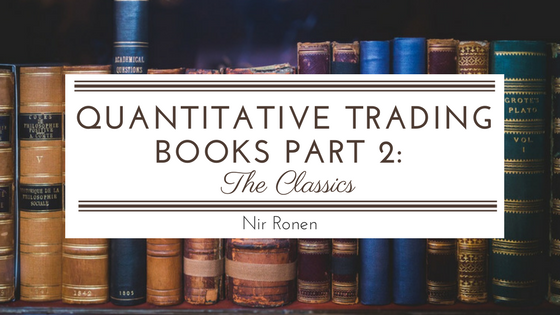Not too long ago, I covered some quantitative trading books, most of them published within the last few years, that offer some useful tips and information for anyone looking to get into quantitative trading. Now I want to focus on the classics, because although you could argue that a book published nearly a hundred years ago is archaic, these books still resonate with audiences today. A common thread among them is that they do not focus on trading strategies or ‘secrets’. Rather than teaching one how to trade or how to get into the industry, they focus on human behavior- the fear, greed, and personality traits that drive top traders and contribute to their success.
Here are a few classics worth checking out if you have an interest in quantitative trading or the stock market:
- Reminiscences of a Stock Operator: Edwin Lefèvre, forwarded by Roger Lowenstein (1923)
Originally published in 1923, this is by far the oldest book on the list. I mean, this was written in the pre-depression era economy. However, it still holds a lot of relevance today. Even after going through so much fluctuation, the stock market operates much the same way it has all along and the behaviors of traders remain the same. The book has a timeless quality, with Goodreads describing it as “the most widely read, highly recommended investment book ever read.” Many readers find that this classic novel written from the perspective of an early Wall Street trader has more to teach them about trading and human nature than years of experience do. According to one reviewer:
While the rules and regulations of Wall Street have changed dramatically since this book was first published in 1923, human nature remains virtually unchanged. Fear, greed, hope and pride are the same today as they were in the early 1900s and these core fundamental human emotions can account for the rise and fall of every Wall Street trader, from the tiny retail players to large hedge fund and private equity fund managers.
- Liar’s Poker: Michael Lewis (1989)
This autobiography is also written by a successful Wall Street trader, in which he chronicles his rise from a trainee at Salomon Brothers investment firm to a prominent bond salesman. Lewis’s story underscores the fact that trading stocks can be a very lucrative business, but traders don’t become millionaires overnight. It takes hard work, dedication, and relentless ambition. With wisdom and humor, Lewis presents an “insider’s account of an unprecedented era of greed, gluttony, and outrageous fortune.”
- Market Wizards: Jack D. Schwager (1989)
Also published in 1989, Market Wizards is a collection of interviews with top traders. As far as detailed, personal accounts of the stock market go, this book is unrivaled. The book is divided into four sections in which Schwager interviews traders from a variety of markets to get their personal philosophies and then summarizes the key takeaways from each interview.
- When Genius Failed: The Rise and Fall of Long-Term Capital Management: Roger Lowenstein (2000)
Okay, so I don’t know if this one can exactly be considered a classic, as it was published 17 years ago, but a lot can change in seventeen years, especially considering the volatility of the stock market. Like the others on this list, this book offers timeless insight into the human motivations driving trends in the stock market. American journalist Roger Lowenstein draws from interviews with high-stakes traders to explain the rise-and-fall of Long-Term Capital Management in the nineties that would serve as an omen of things to come for Wall Street.
- Pit Bull: Lessons from Wall Street’s Champion Day Trader: Martin Schwartz (1998)
The title of this book may be a little misleading for anyone who’s not familiar with the famous Wall Street trader, Martin “Buzzy” Schwartz. Schwartz, who earned the name “Pit Bull” for his killer trading instincts, tells in his own words how he rose to the top on Wall Street, and shares the traits and steps he employed that allowed him to make millions.
As you can see, these books may not be the newest trading tales on the market, but their timeless focus on the human behaviors that shape the stock market will appeal to readers of any generation.

